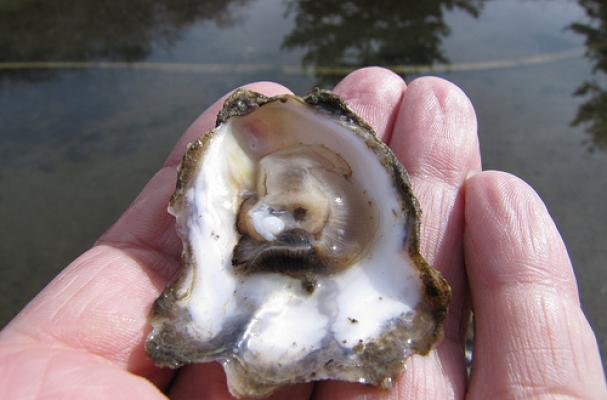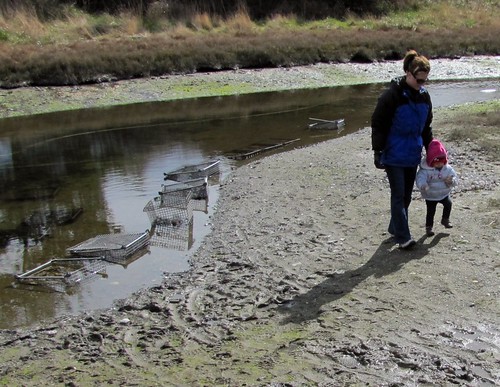
Note: This is the first in a two part series, check back next week for our visit to the Jones Family land farm
Sheri, Emery and I recently traveled to Lopez Island in the the San Juan Island group of Washington State for an inspiring and appetizing visit to the Jones Family Farm and their Sweetwater Shellfish Farms. Owned and operated by Nick and Sara Jones, this is one of the most interesting and diverse small food producers in the world. They both farm the land and the sea producing extremely high quality and unique varieties oysters, clams, goats, pigs, and beef. Their product is available for direct purchase and at some of the best restaurants in the Pacific Northwest, including:
After chatting with Nick on the phone, we planned a weekend visit to the Island, located a couple of hours North of Seattle. We drove up on a Saturday morning and took the large ferry over to Lopez, spending the rest of the day driving around the island and then a night in a small local resort. Lopez is fairly flat relative to the other San Juan Islands and covered by a combination of cedar forests and farmland, with beaches, coves and inlets around each turn...it reminds me very much of Maine or a "Vermont by the Sea."
After overcoming spotty cell coverage, we managed to connect with Nick, Sara and their three delightful boys on one of the Island's country roads. Following Nick in his "No Farms, No Food" bumper-stickered minivan, we arrived at the shellfish farm that is located on about 5 acres of tidal flats with a man-made lagoon. As the boys ran down to the water to play, Nick started the tour. Passionate about his work, this father and farmer resembles Harry Potter, but speaks with the knowledge and authority of a college professor.

Part of what makes the farm so unique is the protected lagoon where the farm starts out the young oysters and clams. With slightly lower salinity levels and high amounts of nutrition in the water that flush twice daily with the tides, the pool creates an ideal environment for the shellfish to develop the unique flavor that makes their products prized by high end restaurateurs. Once the "seed" has grown to a certain maturity, workers relocate them to the tidal flats of Puget Sound to finish. Nick says "what we do isn't really farming, but more staged hunting and gathering." As we talked, he confirmed what I suspect, this is not an easy way to make a living. It requires a lot of experimentation and hard work. What works elsewhere doesn't always translate to a new inter-tidal area. In fact, they recently lost thousands of dollars worth of clams when an unusually heavy rain rapidly lowered the salinity level of the water and killed a whole crop. Thousands of their now empty shells serve as a reminder of how fragile this environment is. Though such an event is unusual, the seagulls and a variety of other wild animals are constantly preying on the farm's wares.




As we walked and talked, Nick opened a variety of oysters for us to taste, including the small round native Olympia or 'Olys," Pacifics, and the increasingly rare European flats, also known as Belon oysters. As we walked down to the flats, I started picked up "feral" oysters that had "escaped" from the farm and, armed with my own oyster knife, opened them slurping each down noting varying levels of brine, sweet, meaty, and creamy flavors. As much as I love a good cocktail sauce, lemon, or mignonette on raw oysters, it was wonderful to taste them like this straight off of the sand.


Cold and windblown, we next headed into a warm and humid greenhouse newly constructed on the spit of land next to the water. Here's the Jones family is developing a business to produce oyster, clam and geoduck seed for themselves and other shellfish farmers in the area. If you are not familiar with the geoduck (pronounced gooey-duck), it is an unusually large clam with a long and suggestive looking siphon. A traditional food of the local Indian tribes, geoducks have also long been eaten in chowders here locally. Capable of reaching up to 15 lbs and several feet in length, these native mollusks live for up to 150 years. Their recent popularity in Asia has caused prices to jump with a pound going for up to $150 in China. Unfortunately, this has led to a rash of geoduck poaching, which was featured in a recent NPR story: "The Case of the Stolen Geoduck." Microscopic in their early phases of growth, we saw a bucket sized tank that Nick said contained over 100,000 live geoducks...to us it looked like about a teaspoon of sand!
After viewing the shellfish operation, Sara and Nick invited us to tour the "land farm" and visit their home at the South end of Lopez. Check back next week to read more about the Jones Family Farm and a hauntingly delicious lunch of clams and farmhouse sausage. In the meantime, here more photos of our time at this amazing place.









Image Sources:













Comments
March 26, 2012
Any chance you can adopt me so I can go on your next trip? Looks like you had a wonderful trip with the family!
April 9, 2012
Great Oysters! I love oysters but they seem small. Bring out the soy sauce, vinegar and some hot cooked rice and it will be delicious. Dip some oysters in the Soy sauce and eat together with rice.
Lisa @<a href=" http://www.dbphoenixcriminallawyer.com ">phoenix criminal attorney</a>
April 9, 2012
Adopt me as well!